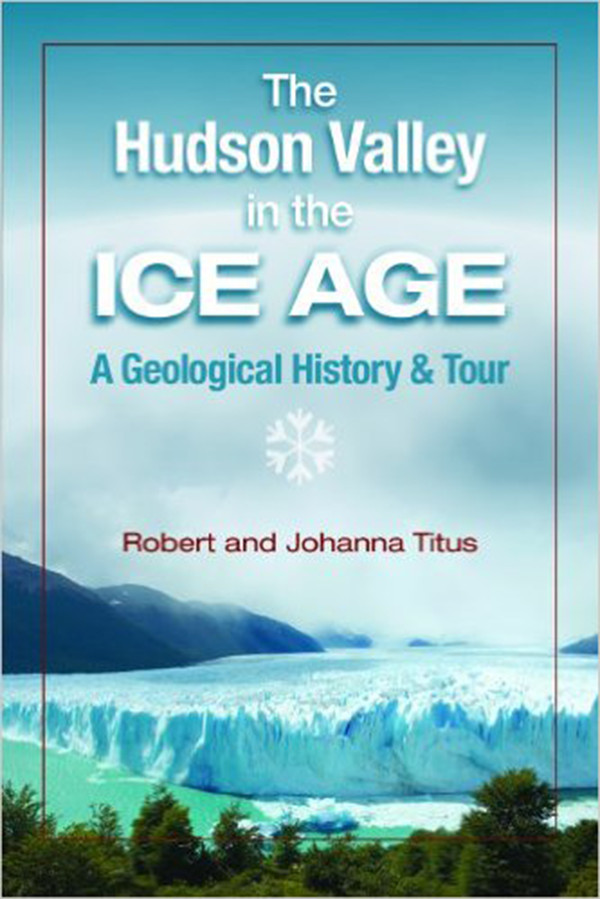
by Robert and Johanna Titus Friday, May 20, 2016

One might think ice age history an unlikely topic for a popular science book, but our 2012 book, “The Hudson Valley in the Ice Age,” seems to have struck a chord with the public. Over the last few years, we have built upon our success to highlight local awareness of our Hudson Valley and Catskills regional geology. We thought our story might encourage others to undertake similar efforts in their own communities.
It began when our book was included on a list of Christmas gift suggestions by an Albany television station, which soon afterward invited us to appear on one of their Sunday morning interview shows. After that, the speaking invitations started pouring in: first from local libraries, then historical societies, environmental groups, hiking clubs, art museums and book stores.
We were even asked to speak at a meeting of a kidney research association; they had heard about us while looking for interesting speakers outside of medicine. We developed an ice age hike for the annual Hudson River Valley Ramble, a series of events celebrating the region’s cultural and natural history.
Because our book discussed how ice age landscapes inspired the landscape painters of the Hudson River School of Art, as well as many of America’s pioneering landscape architects, we were also able to reach the artistic community. This led to speaking invitations from the Albany Institute of History and Art and the Roosevelt Presidential Library in Hyde Park.
It also led to our contribution to the Hudson River School Art Trail, which highlights many of the most important sites and views painted by artists like Thomas Cole, Frederic Erwin Church and Asher Durand. We visited Art Trail locations and put together accounts of how geologic events had shaped each one. Glaciers had advanced down the Hudson Valley and then rose up into the Catskills. They had shaped the Catskill Escarpment and many of the area’s lakes. As the glaciers were melting, torrents of meltwater eroded picturesque gorges and canyons. The artists were drawn to these scenic locations, most of them not realizing that the ice age was responsible for their raw beauty.
We have also partnered with local civic groups, such as area land conservancies, which are dedicated to preserving parcels of land and keeping them free of development. Their members form a natural constituency for geology outreach. Land conservancy members generally feel a strong attachment to the land, but often do not have in-depth knowledge of its geologic history. Thus, they make for extremely responsive audiences, and such groups are often looking to sponsor events for their members, typically including lectures and nature walks.
When the Woodstock Land Conservancy — founded to protect an especially scenic cornfield that was threatened by developers — was planning to celebrate their 25th anniversary, they invited us to speak. You can imagine their surprise and pleasure when we informed them that their treasured cornfield had once been an ice age lake. Another of their properties, Sloan Gorge, had formed as an ice age meltwater spillway. We volunteered to make this a formal geology trail and worked with the conservancy to create a trail guide for self-guided tours. Today, it’s one of their most visited preserves. We did much the same for the Columbia Land Conservancy, for which we led a geology walk on one of their properties on the east bank of the Hudson River. That property had once been on the floor of Glacial Lake Albany.
We continue to do what we have done annually for the last 25 years: give dozens of talks and write about 70 geology columns, which are syndicated in regional weekly, monthly and quarterly publications. These, along with the book, our talks and trail guides, have opened doors for us to communicate with the general public about our local geology. We believe that we continue to reach many people who may not otherwise ever be exposed to geology, and help make them aware of the role geology has had in shaping our regional culture.
We encourage you to reach out to those constituencies in your community who perhaps wouldn’t otherwise be exposed to geology and to find new ways to share your knowledge with them.
It won’t make you rich, but at the end of the day, you will feel good.
© 2008-2021. All rights reserved. Any copying, redistribution or retransmission of any of the contents of this service without the expressed written permission of the American Geosciences Institute is expressly prohibited. Click here for all copyright requests.